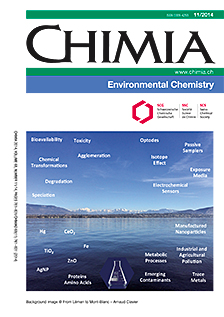Manufactured Nanoparticle Behavior and Transformations in Aquatic Systems. Importance of Natural Organic Matter
DOI:
https://doi.org/10.2533/chimia.2014.783Keywords:
Aggregation, Aquatic systems, Disagglomeration, Nanoparticle coating, Natural organic matterAbstract
Major concerns to elucidate the fate of nanomaterials and manufactured nanoparticles in aquatic systems are related to the lack of data on nanoparticle transformations under relevant environmental conditions. The present article discusses some of the important physicochemical processes controlling the behavior of manufactured nanoparticles in aqueous systems by focusing on their interaction with natural organic matter, which is expected to play a crucial role when adsorbing at the nanoparticle surface. The precise knowledge and consequences of such adsorption processes are important not only to predict the nanoparticle stability and dispersion state but also to evaluate their chemical reactivity and ecotoxicology. Most importantly, findings indicate that the presence of natural organic matter, at typical environmental concentrations, can induce significant disagglomeration of large nanoparticle agglomerates into small fragments. Such a result constitutes an important outcome with regard to the risk associated with the possible transformation and redispersion of large assemblies containing manufactured nanoparticles.Downloads
Published
2014-11-26
Issue
Section
Scientific Articles
License
Copyright (c) 2014 Swiss Chemical Society

This work is licensed under a Creative Commons Attribution-NonCommercial 4.0 International License.
How to Cite
[1]
Chimia 2014, 68, 783, DOI: 10.2533/chimia.2014.783.







